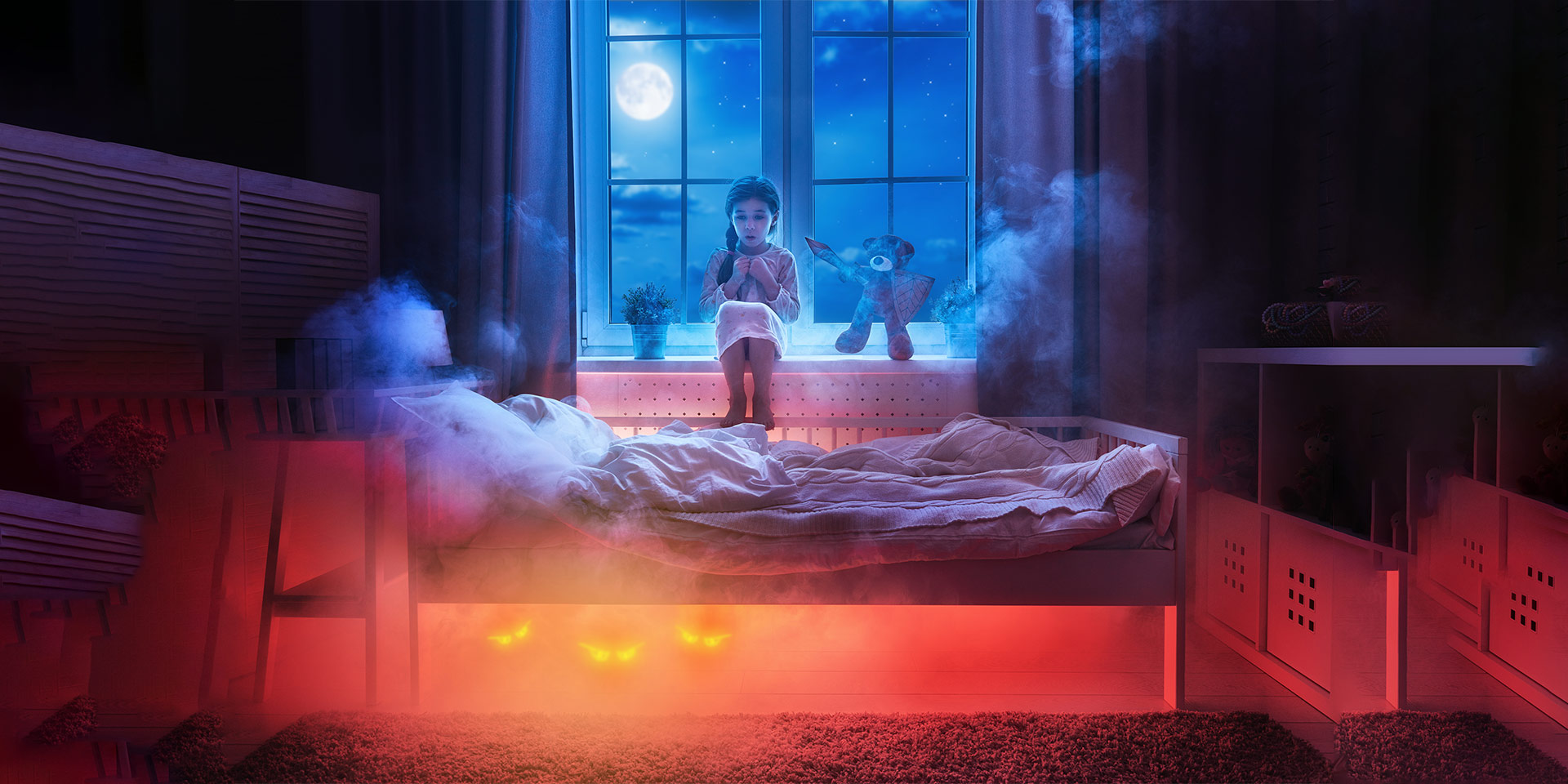There is no monster under the bed—that much is certain. But how do you convince your child of this, when they come to you, for the hundredth time, with the same fear? When you constantly use the same unheeded command, “Stop fooling around and go to sleep!” this is a sign that you need to learn more about your child’s anxiety, and how you can fight it together.
Adults today may feel more entitled and free to admit their own anxiety when talking to others, compared to how they felt even a decade ago. However, this freedom only includes adults talking with and about adults. The discussion about children’s anxiety has not kept pace with the conversation about adult anxiety, which is why resources for parents who need to manage their children’s worries are not as easily available. What is more, if the parent is unable manage his or her own fears, this is the perfect recipe for disaster.
Child care
“Ah! To be a child without a care in the world!” This is definitely a cliché, but it’s an untrue one. Children worry about a lot of things. Many of these worries are part of the normal growth process, and they disappear, one by one, as the child matures. But when the little one’s worries or fears affect his well-being, when he is irritable, crying or clingy, he can’t fall asleep quickly, he has nightmares, he falls asleep, or he wakes up during the night, this is a sign that he might need help from you to manage your fears.
Generalized Anxiety Disorder (GAD): Children with generalized anxiety worry almost every day about various things. Of course, most children worry about things like homework, tests, or mistakes. But children with GAD worry more and more about all these things. A child with generalized anxiety may also worry about things that their parents might not expect. For example, he might worry about recess, his birthday party, his play with friends, fear of terrorists, war, weather, or the future. Such children may have concerns about their loved ones, their safety, any illnesses they may have, or ways in which they may be hurt.
Children with GAD may find it difficult to concentrate at school because there is almost always at least one negative concern in their mind, at least one worry. They have difficulty relaxing, have problems eating, or falling asleep at night. Some children with GAD keep their worries to themselves. Others talk about their worries with a parent or teacher. They may always wonder if something they are worried about will happen and, no matter what the adult tells them, it will be hard for them to feel good.
Separation Anxiety Disorder (SAD): It is normal for babies and very young children to feel uneasy when they are left without their parent for the first time. But they quickly get used to being with a grandparent, a nanny, or a tutor and start to feel at home in kindergarten or school.
However, some children fail to get used to the idea of being without their mother or father and can hold onto this fear as they become adults. Adults with a history of SAD are very anxious when they are away from their parents or away from home.
Children with SAD will avoid going to kindergarten or school as much as possible. They will say they feel unwell or too upset to go. Some will not want to sleep alone in a room, go to a sleepover, or do activities in general without having the parent close.
Social phobia (social anxiety disorder): Children who struggle with social phobia are terrified of what others will believe or say. They are always afraid that they might do or say something embarrassing. They worry that they might sound or look weird. They don’t like to be the centre of attention. They don’t want others to notice them, so they might, for example, avoid raising their hand at school. If they need to talk in class, they freeze or panic. A public presentation may seem like a terrifying impossibility to them.
Social phobia can cause children and teenagers (who are most sensitive to the opinions of others) to avoid school or friends. They may feel sick or tired before or during school. They may complain of other sensations in the body, which are also associated with anxiety, such as palpitations or suffocation. They may feel agitated, red in the face or hot, and may tremble or feel dizzy.
An extreme form of social phobia is selective mutism (MS), which occurs in children who have the ability to speak, who talk at home or with very close friends, but refuse to talk at school, with friends, or in other places that scare them.
Specific phobia: Who doesn’t remember that they were once afraid of the dark? Maybe even of monsters, of thunder and lightning, or even of an animal? These common fears are often alleviated with the help of adults, but when suffering from a phobia, the child feels an extremely intense and much more lasting fear. The child who has a specific phobia will try to avoid the object of fear at all costs and will be terrified and hard to comfort if they are not able to avoid it.
How do you recognize your child’s anxiety?
Anxiety grows into a problem when it becomes an obstacle in a child’s daily life. When they withdraw from normal, beneficial activities for a child their age, when they refuse new experiences and run away from them for fear that things will go wrong, it is time to confront their anxiety. For example, it is perfectly normal for a school-age child to feel nervous on the morning of an exam and think about how everything will unfold. But some children may be so nervous that they can’t find the strength to go to school that morning.
Unfortunately, severe anxiety can affect a child’s mental and emotional health, while damaging their self-confidence and self-esteem, creating a vicious circle that alienates them, making them more and more withdrawn, and increasing their suffering.
Children who are a little older can manifest their anxiety through symptoms that can be easily misunderstood and treated as something other than anxiety:
- lack of confidence to try new things (although they are at the age of exploration, when the whole world should be a huge laboratory) and an inability to face the simple challenges of everyday life;
- difficulty concentrating;
- sleeping/feeding problems;
- violent outbursts;
- a pessimism made up of a multitude of negative thoughts or premonitions that something very bad is about to happen;
- avoiding daily activities (going out to school, visiting friends).
Understanding your child’s anxiety
For parents who notice symptoms of anxiety in their child, psychologists recommend that they accompany them through fear, so that children can learn as much as possible about their emotional universe, in a setting where they feel safe, in order to develop the psychological tools they can turn to whenever they face anxiety.
It may seem to the parent that the little one is an endless reservoir of ‘what ifs’ and that every reasonable answer they give to these questions only triggers more of the same question.
Lawrence J. Cohen, author of The Opposite of Worry: The Playful Parenting Approach to Childhood Anxieties and Fears, says that at the heart of ‘what ifs’ (What if you get hit by a car on the way to the store? What if Daddy is late because he got sick and died? What if Grandma will get sick and can’t walk? What if Grandpa will fall on the stairs when he comes to pick me up from school? etc.) are three of the most common symptoms of anxiety:
- indecision (“What if I go to the park when my favourite cartoon is on TV?”)
- perfectionism (“What if I make a mistake?”)
- over-training (“What if this or that or the other happens?”)
What ifs are repetitive, stressful questions that do not produce creative or useful solutions. Instead, they produce terror, as if they were real.
One of the solutions that Cohen proposes to this type of anxious thinking is to confront it, to recognise its irrationality, to respond to irrational thoughts, and to help the child live in the present. Anxious thinking often oscillates between review and rehearsal: we continually review what we have done, to see if it was good, or what we could have done differently, and we continually practice for the future, rehearsing each scenario among the infinite number that are possible. Children caught between review and rehearsal need to anchor themselves in the present, to change the ‘what if’ questions with questions that help assess what is reality, in the now.
Reason and logic unfortunately fail to help, says Cohen. We will never witness a discussion about monsters under the bed end with the child saying, “Okay, Mom, thank you for telling me monsters do not exist. Good night!” But fortunately, this does not mean that there are no other ways to combat anxiety.
Start with empathy! Children will not be able to hear the arguments by which you contradict their fears unless they first know that you understand how they feel.
Challenging should not mean quarrelling: If you argue, anxious thinking is not effectively countered, even if you, the parent, are “right.”
The strongest challenges come from within: It is important for a child to develop his own thoughts that help him challenge anxiety, as he will probably not be able to use the same solutions his parent uses when coping with fear.
Before you contradict the little one’s anxious thoughts, challenge your own!
Games that drive away fear
One of the reasons why anxious thoughts are hard to fight is that we feel them as if they are real. That is why compassion and patience are indispensable. The area of the brain called the amygdala is responsible for expressing fear and aggression, and scientists have observed that people who suffer from anxiety or post-traumatic stress have a hyperactive amygdala.
This has led researchers to believe that intervening on the brain circuit of fear is a solution to treating anxiety. Some types of anxiety disorders can be medicated and/or treated with the help of verbal therapy (cognitive behavioural therapy benefits from the best scientific support). But, psychologists say that in the case of disorders that are not suitable for drug treatment, it can be useful to intervene by methods that stimulate other parts of the brain. Parents could opt for such a strategy, encouraging the child to move, to engage in creative or other activities that they enjoy.
“Doing the silly dance” is a game meant to divert the little ones from their anxious thoughts, by counteracting those thoughts with physical activity. As the name suggests, the game involves parents and children shaking off their fears by dancing, no matter how silly it may look, mimicking the trembling of fear or any other movements that the child can imagine.
Anxious children have very active imaginations, therefore another possibility to intervene is through play. Parents can teach the little one to dispel her anxiety by “pulling its leg” with a “fortunately/unfortunately” game. The game consists of alternating sentences related to each other that start with “fortunately” or “unfortunately”: “Fortunately, today is a beautiful day,” says one player. “Unfortunately, it’s raining,” says the other. The idea of the game is to challenge the impenetrable seriousness of thoughts of concern and to provide the child with a framework in which she can freely express her desire to create catastrophic scenarios.
“What if not?” is another game meant to drive away anxious thoughts, by challenging them. One player expresses a worrying thought: “What if you turn into a hen?!”, and the other responds with: “Yes, but what if I don’t turn into a hen?” The aim of the game is for the little ones to be able to laugh together with their parents about their most pressing fears and at the same time to make room in their thinking system for the possibility that the dark thought might not materialize.
Older children can be helped to learn how their anxiety works through games such as: “Spy” or “Scientist’s Laboratory“, during which they must gather as much information as possible about their fear: “When does it appear? When is it at its peak? When is it at its least intense? What does anxiety keep me from doing? What does it push me to do? How is my body feeling all this time? How would my anxiety react if I challenged it? What happens to my anxiety when I practice breathing techniques?” The child can thus learn that anxiety is like a wave that increases in volume before it breaks on the rocks; that it comes on a crescendo, after which it passes. And that he can observe this movement of the waves, without taking it as the ultimate reality of his life.
The arsenal of tools and techniques to fight against anxiety therefore works with logic, emotion and the body to build a whole system that resists worry and fear. Confidence in our heavenly Father is also important. Therefore, we should teach our little ones that they can always ask for help through prayer, seeing how He drives away even the most frightening monsters. The good angels who guard us all, and their loving parents, are their allies—and they are strong.
Alina Kartman is a senior editor at Signs of the Times and ST Network.



















